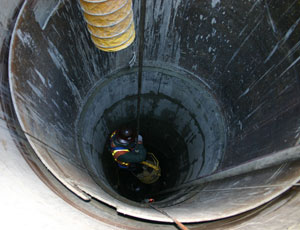Some time ago, a colleague called to get my opinion on the use of TV cameras for underground inspection of drilled shafts. His query related specifically to relatively tight working areas and “in the dry” conditions. After pressing him to elaborate further on the context of his question, I discovered that he was weighing the benefits of TV inspection versus human entry into the drilled shaft excavation site.

This conversation is indicative of a larger movement that has been afoot for the past few years that seeks to discourage - or even eliminate - personnel from entering drilled shafts to clean or inspect the bottom. Although there are many reasons as to why TV inspection is increasingly favored over human inspection, there are two fundamental reasons behind this push for TV inspection. First, some contractors believe that they can achieve better, faster and cheaper results if the inspecting engineer simply stays out of the way. Second, some contractors and engineers are concerned with the liability/insurance issues that come into play if anything was to happen, for whatever reason. While there is a degree of truth and merit behind both of these reasons, it is my unwavering belief that human inspection must be favored over TV inspection in certain conditions, and that human entry into the excavation site is a necessary part of the inspection process that cannot be eliminated.
For the majority of my forty-year career, I have dealt with drilled shafts (or caissons) in one capacity or another and have literally been in and out of drilled shafts hundreds of times. Is TV inspection suitable for drilled shafts? Sometimes. Is it always? Absolutely not. I will take as proof of this assertion a drilled shaft job in Boston that we are currently finishing up. Over the course of this project, we have encountered very erratic and sometimes cliff-like changes in rock bearing elevations, as well as rock strengths. Getting a “seal” in the rock below the ground water table and installing two-inch vibration isolation material inside the steel casing only added to the challenges of this project. Both the geotechnical and structural engineers were extremely concerned with our work in regard to the rock bearing surface and entry into the shaft played an integral part in mitigating their concerns. Each shaft was inspected and approved by the geotechnical engineer, and in the end, they were extremely pleased with the product. I believe that entry into the drilled shaft was a key component in securing their confidence and approval because it provided them with a comprehensive perspective that simply could not have been secured with a TV inspection.
I am a strong proponent of making the engineer comfortable with the end result that he/she is getting. If we, the contracting industry, don’t do that we only hurt ourselves. If that can be accomplished with TV inspection, then fine and so be it. However, many times, such as in the scenario I just described, the engineer has to or wants to enter the shaft. Whether to check on the size and bearing strength of a belled caisson in clay or to experientially examine (through sight, smell and touch) the bearing surface of soil or rock, sometimes the engineer must enter the drilled shaft.

ROMA
Is there risk in entering drilled shafts? Absolutely! However the risks can be dramatically decreased by following standard industry operating procedures. And these procedures have only gotten better and more rigorous over time. ADSC - The International Association of Foundation Drilling has developed many manuals, one of which is the “Recommended Procedures for the Entry of Drilled Shaft Foundation Excavations.” That manual includes, among other things, provisions for air monitoring.
Together with ADSC, the U.S. Occupational Safety and Health Administration (OSHA) also furthers the work of developing and implementing safer and more efficient practices for human entry into drilled shafts. Both of these organizations should be commended for their untiring dedication to the safety of individuals working in this industry. However, what has frustrated me lately is the personal spin that is often put on OSHA rules and regulations. Whether it be out of political motives or ignorance or laziness, often these rules are ignored or not implemented properly. It is our duty, out of concern for all of those that we work with, to ensure that these guidelines are obeyed to the best of our ability. We must remember that these rules and fines are in place for a reason and need to be heeded.
The point I am ultimately trying to make is that human entry into drilled shafts should not be relegated to a subordinate position, or disposed of entirely. In certain cases, TV inspection is adequate; in others, it is not. Further, when done properly and according to the standards developed by the ADSC and OSHA, human entry into drilled shafts can be completed relatively safely. Maybe it’s my old-fashioned view presenting itself here but it is my belief that there are still some tasks in life in which the human outperforms technology in getting the job done; and inspection of drilled shafts is one of those tasks.


Post a comment to this article
Report Abusive Comment